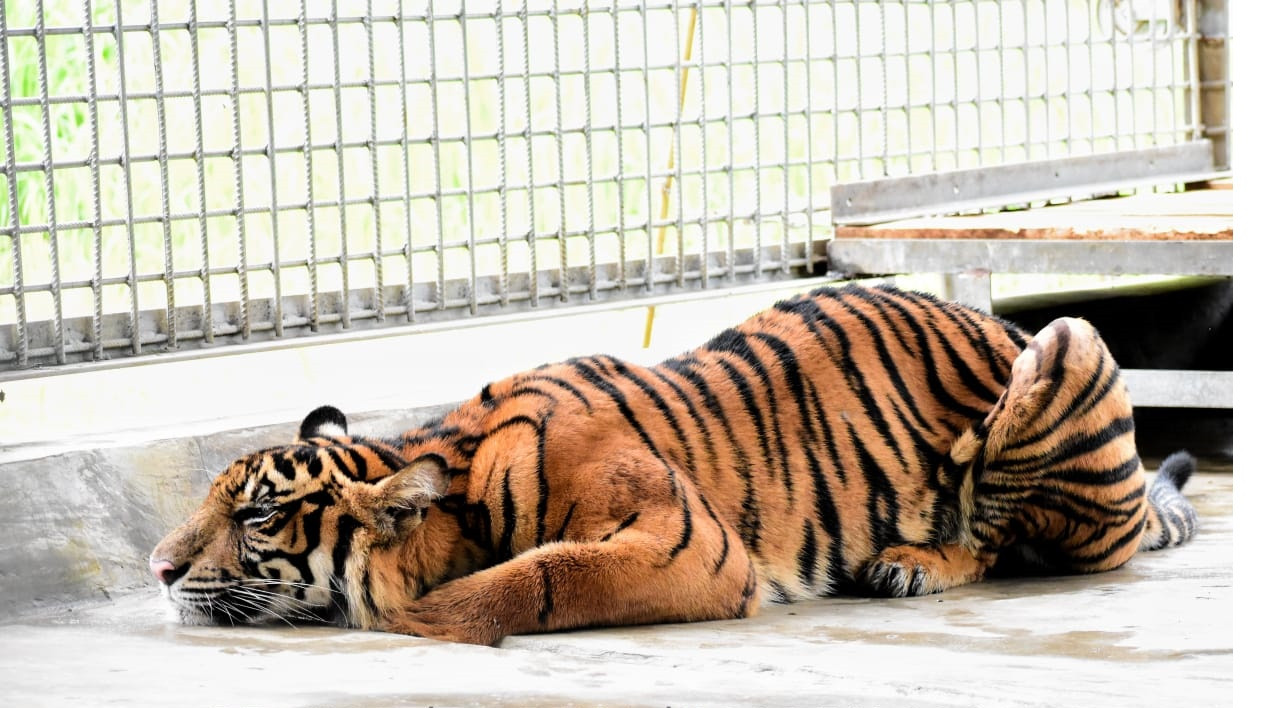
The recent birth of a Sumatran tiger, a critically endangered species native to Indonesia, at the Wroclaw Zoo in Poland is a welcome development, as its wild relatives continue to face threats in their natural habitat in Indonesia.
The female cub was born on May 29 from her 7-year-old mother Nuri and 11 year old father Tengah, but news of her arrival was made public only recently. The cub is yet to be named and the zoo has invited the public to offer suggestions via its Facebook account.
There are 402 Sumatran tigers in captivity, 130 of which are in Indonesia, with the rest in zoos in Europe, Australia, Japan and the United States, according to Indonesian Environment and Forestry Ministry.
“Sumatran tigers overseas are from wildlife exchanges between Indonesian zoos and foreign zoos – some are also gifts from Indonesian presidents when visiting other countries in the past,” the ministry 's biodiversity conservation director Indra Exploitasia told The Jakarta Post on Monday.
Indra said human intervention in the form of a global species management plan to improve genetic variation among Sumatran tigers was needed after the ministry found in a 2016 study that tigers in captivity were less genetically diverse, increasing their likelihood of becoming extinct. Such an intervention could also prevent inbreeding, which can cause serious genetic problems.
“In Indonesia, we recommend that Sumatran tigers in captivity be exchanged between zoos. We will soon include Sumatran tigers abroad while also recording them in a studbook,” Indra said.
Read also: Habitat loss pushes Sumatran tiger out of forests, into conflicts with humans
Wildlife trafficking expert Dwi Nugroho Adhiasto from Wildlife Conservation Society’s (WCS) Indonesia office said that tracing every Sumatran tiger born in captivity was key to their survival, as their natural habitat and numbers in the wild continue to decline.
About 600 Sumatran tigers are believed to remain in the wild, according to a government estimate. Native to the island of Sumatra, the tigers are considered critically endangered by the International Union for Conservation of Nature (IUCN).
The Sumatran tiger is the only surviving subspecies of the Sunda Islands tigers that once included the now-extinct Bali and Javan tigers. Compared to its other living relatives, like the Bengal tiger and Indochinese tiger, the Sumatran tiger is the smallest in size, with stripes closer together, darker orange fur and a beard and mane.
Global Tiger Day is commemorated across the globe on July 29 every year to raise awareness about tiger conservation.
At home, some conservation groups have hosted numerous campaigns to celebrate the day in the past.
But poaching and conflict between humans and Sumatran tigers persist in Sumatra, especially in areas where rainforest is cleared to make way for plantations, often leading to the deaths of tigers.
Read also: COVID-19 won’t stop Indonesia from conserving endangered wildlife treasures
A Sumatran tiger was found dead after reportedly ingesting toxic substances in South Aceh, Aceh on June 29. A suspect has not been named in the case.
The incident came about a week after the Aceh Police arrested four suspected poachers for killing another Sumatran tiger. The poachers allegedly trapped the animal and left it to die. The police confiscated the tiger pelt along with teeth and bones from the suspected traffickers.
In neighboring North Sumatra, a buried carcass of a male tiger was uncovered in Batang Gadis National Park on June 23. The tiger’s pelt and organs were missing.
In a separate case in Riau, a tiger was found dead in a conservation area in Siak on May 18 with one of its legs caught in a wire trap.
Read also: Endangered Sumatran tiger found dead, ensnared in Riau
Poaching accounts for almost 80 percent of Sumatran tiger deaths, according to TRAFFIC, a global wildlife trade monitoring network.
Deforestation has intensified conflicts between humans and tigers and increased the risk of extinction of the Sumatran tiger, the Zoological Society of London's (ZSL) Indonesia program warned. In South Sumatra alone, the four remaining natural habitats for tigers are shrinking because of deforestation, ZSL said. The four habitats are among just 23 areas suitable for Sumatran tigers across Sumatra Island.
Dwi from WCS said the tigers could easily reproduce in the wild, so protecting their habitat was more important than trying to release those in captivity into the wild. He said the carrying capacity of Sumatran tiger habitat – how many animals a certain environment can support – must be improved by making sure they have enough prey, sources of water and mates.
“Captivity is the last resort if the population in the wild declines,” Dwi said. “But, what good is that hard work [of releasing tigers in captivity into the wild] if they still face threats in their natural habitat?”
"captivity" - Google News
July 29, 2020 at 05:34PM
https://ift.tt/338BTY6
Sumatran tigers face perilous future as efforts made to improve breeding in captivity - The Jakarta Post - Jakarta Post
"captivity" - Google News
https://ift.tt/3b01anN
https://ift.tt/3dbExxU
Bagikan Berita Ini














0 Response to "Sumatran tigers face perilous future as efforts made to improve breeding in captivity - The Jakarta Post - Jakarta Post"
Post a Comment